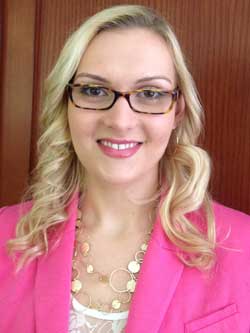Filed Under > Convocation
Daniela Orasel: finding a calling to change lives
Growing up in the Sunnyside section of Queens, Daniela Orasel knew she would one day attend Columbia University. Her only uncertainty was about what she would study.
Orasel embarked on her undergraduate work at Binghamton University, intending to become an attorney. Then she “fell in love” with psychology, switched programs, and trained at Binghamton in Applied Behavioral Analysis (ABA), a method in which the teacher records detailed information about each student’s behavior and learning progress. That information is used to develop a learning plan incorporating classroom conditions and teaching tactics that work best for the individual. If one way to teach vowel sounds isn’t working for a child, for example, the ABA teacher can try another tactic.
Orasel worked for 16 months using the ABA technique at the Manhattan Children’s Center, which serves students with moderate to severe autism-spectrum disorders. From there, she followed her dream to come to Columbia and to Teachers College. “I get such a rush of pride when I get out of the subway and see the Columbia sign in blue,” she says.
Arriving at TC well-versed in the ABA method, Orasel branched out and learned about alternative teaching styles for learning-impaired students. Courses with Linda Hickson, Professor of Education, and Hsu-Min Chiang, Assistant Professor of Health and Behavior Studies, broadened her knowledge about the wider range of disabilities she might encounter in a classroom. Ultimately she chose to pursue a Master’s of Arts in Intellectual Disability/Autism in the Department of Health and Behavior Studies in order to study additional methods of curriculum design, teaching and assessment for use with a variety of disabilities, including autism.
She remains a strong proponent of ABA. “We really build a connection with these students,” Orasel says of the ABA technique, which she used in her student teaching. “There’s a rapport and understanding with each and every student.”
In fact, at TC Orasel deepened her knowledge of the ABA model in a course with Alison Corwin, an instructor in the Health and Behavior Studies Department. She also learned about CABAS (Comprehensive Application of Behavior Analysis to Schooling), a method designed by R. Douglas Greer, Professor of Psychology and Education, for teaching autistic and other language-delayed students.
Greer’s teaching system, developed over the past 40 years from the ideas of his own late mentor, the behavioral psychologist B.F. Skinner, is designed to induce preverbal development in children with language deficits, including those with autism spectrum disorders. Greer and his students have demonstrated that the same techniques can be highly effective in mainstream classrooms with children who are English language learners or whose language deficits are the result of growing up in disadvantaged circumstances.
This fall, Orasel will become the inaugural teacher at a brand new school in Brooklyn. She will teach the first class of kindergartners at the new school, an offshoot of the Manhattan Children’s Center. She can barely believe her good fortune and timing. “It’s more than a career path; it’s changing the lives of children,” she says of working with special-needs children. “If you love what you do, it’s not work.”
Published Friday, Jun. 7, 2013
